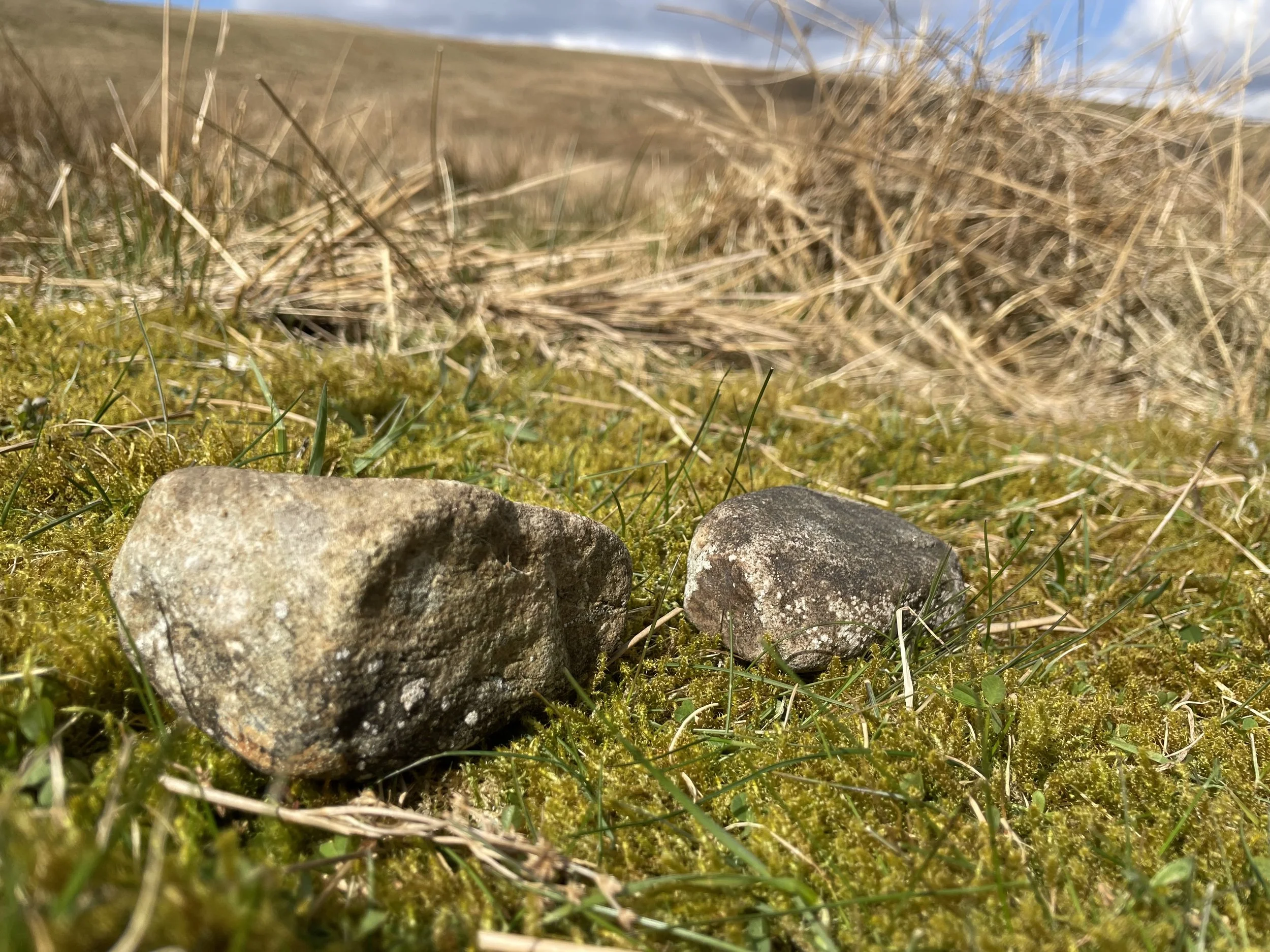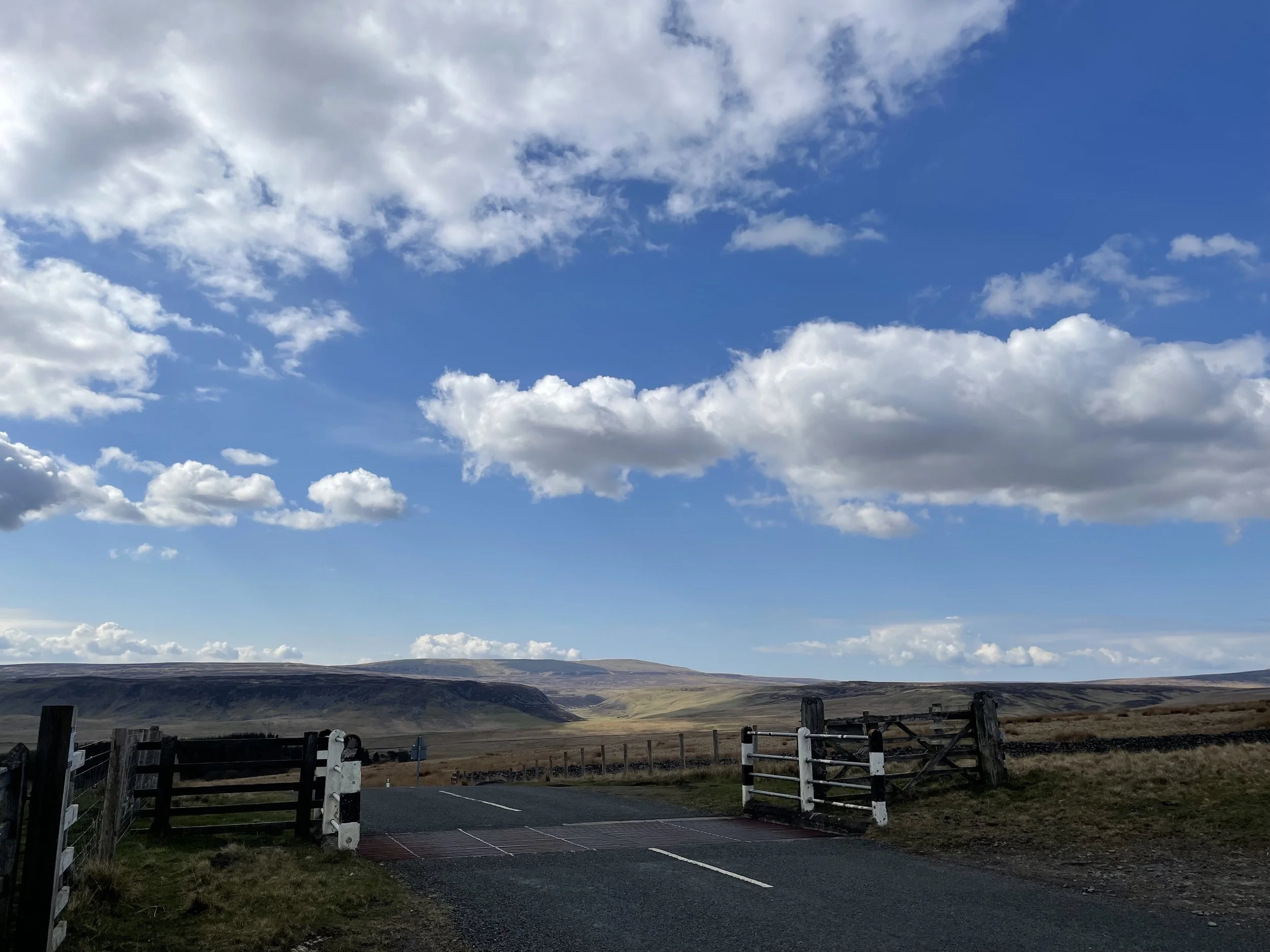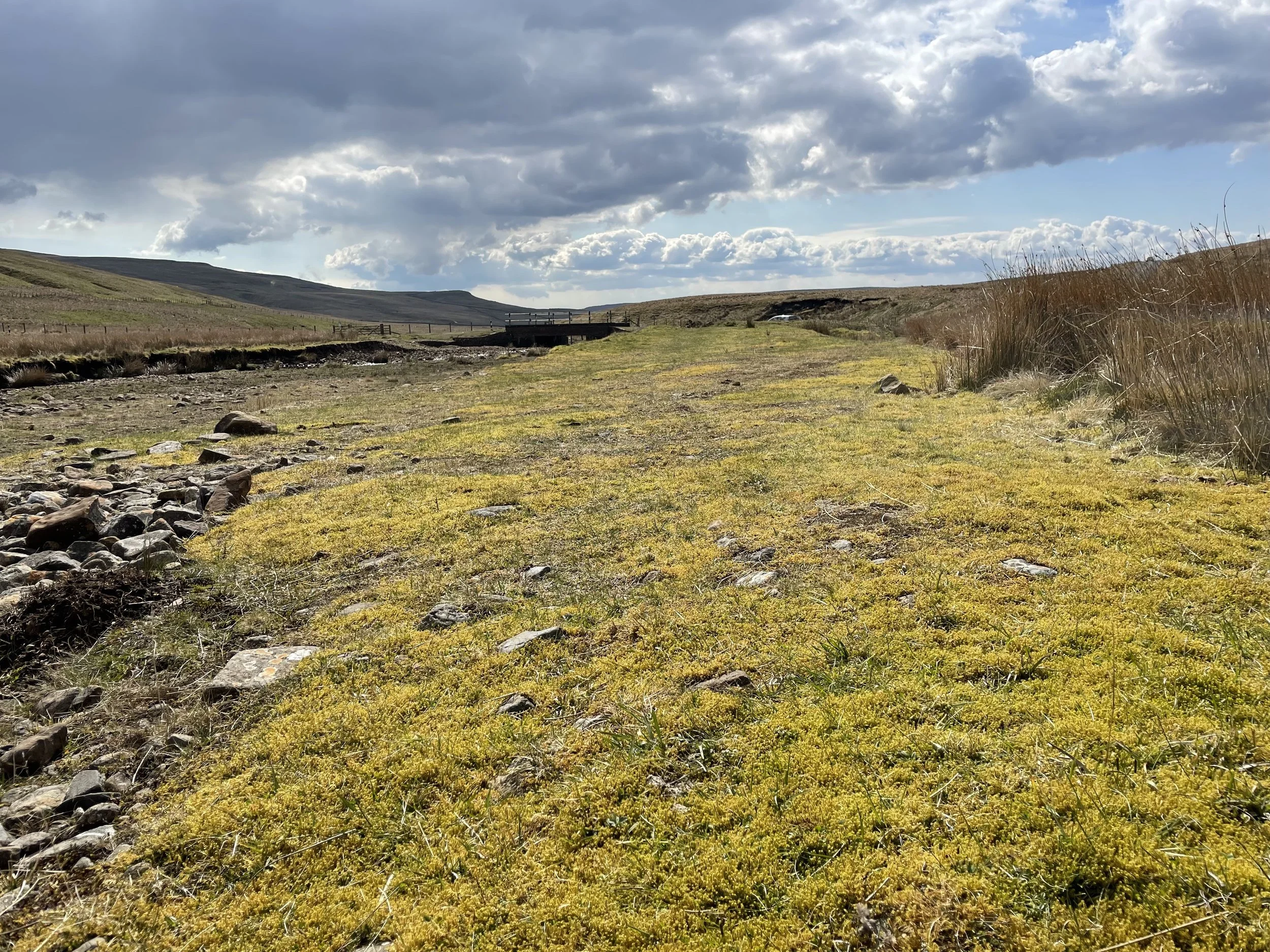Nell Catchpole
APR ‘23: Selected Work / Process
Contents:
1 /2 /3. Practical work in the landscape
4. Presentations
5. Exploratory writing
6. Scoping Areas of Interest (theory, method)
7. Practical projects with local communities
Click the above to navigate to each section.
1. ‘Teesmouth’ for BBC Radio 3, 2023
This sound piece for Radio explored the Tees estuary - it's living beings and geography - and highlighted the current mass marine die-offs, most likely caused by deep dredging to build a new freeport. In situ audio recordings with incidental interviews and live sound improvisation using materials found in place. Recordings were made in November, 2022 and the piece was broadcast in January, 2023.
Excerpts from journal notes:
North Gare 1.11.22
…This turned out to be a flowing series of encounters as I walked the edges of the peninsular at low tide. The encounters were with driftwood and other materials, interspersed with meeting people. Each person I met was a regular visitor, and each shared their particular knowledges about the area. In fact, it turned out that the recordings I made were:
Improvisation with materials : dialogue with a person : materials : etc
I didn't plan it this way and actually didn't expect to meet anybody particularly. But I liked that sense of other people providing a kind of narration to my embodied, sensory experience of this place. In each conversation I introduced myself and the project, acknowledging that what I was doing was a little out of the ordinary…
Approached the far end of the spit where I found an accumulation of driftwood that appeared almost like a layered hedge in its construction. I assumed it was a naturally made pile but later found out it's probably been gradually added to by passers-by. It formed a useful windbreak: Worked with shells and the sand, and then wood upon wood.
Met two fishermen digging lug worms out on the sand. Dave and Tommy.
Sat for a while in the shelter (apparently also built by local bird watchers and walkers over time).
Recorded the landscape from this sheltered spot as well as more wood upon wood. The next encounter was with a walker who works for Tesco's and volunteers to help with keeping the shoreline clear.
Met a bird watcher, Tony, who listed the species he tends to see in the area, especially the migrating birds that come through.
The next encounter was with a large heavy stick upon sand in a sheltered spot.
Finally, hastily recorded the sound of the grass in the sand dunes blowing in the wind.
Experientially this trip felt like it hung together like a long phrase - a continuum of experiences which described this place. There was something significant about how one feature in the physical landscape directed me towards the next; how each conversation offered up new knowledge of the locality; and each sound-making drew my attention to its material…
2. Process I: Moors
I have begun a series of my improvised, ‘ritualised’ performance in the landscape as an ongoing inquiry into my practice. I document each one with spoken journal (‘thick description’), photo and video, and audio recording. My aim is for these iterations to reveal new insights, ahead of developing more substantial, extended projects.
Excerpts from journal notes:
My plan is to park beside the ash tree on the corner where I saw the curlews last week. I may find a single place perhaps using one of the Grouse shelters for cover. I don’t have an endpoint in mind, so the idea is purely to work with that place and the materials and to ‘be’ in it through my ritualised practice…
…I realised as I walked out on the heather that the feeling of possibly impinging on the territory of a nesting bird is very real to me - that it is something I feel in my body as much as I know it intellectually. On top of that, I also know that this piece of land is used for rearing Grouse and that I was probably trespassing. Once I had found a place to stop, near the largest stone, I lay down straight away to make myself as inconspicuous as I could. There followed a long period of settling in… Eventually a couple of brilliantly close curlews sounding and I noticed this coincided with a raptor passing overhead. This was exciting and also made me feel a little bit better about my presence – maybe I wasn’t as conspicuous as I thought - the curlews seemed more aware of the hawk than me.
As I made a video from my vantage point, I was struck by the dramatic sight of the dead heather, pointing up into the blue sky, quite sculptural. I also noticed the sound it made as I had been scuffling around earlier. I improvised with the heather, first with the sound of my hand squeezing or depressing the heather branches. Then, the sounds made by drawing a heather twig across and along the twigs sticking into the air. Finally, everything seemed to come together as I videoed and recorded a short improvisation which included another final, dramatic Curlew moment. I realised the piece of heather I had chosen almost looked like the outline of a curlew’s head and beak.
Without the practice of these sound-makings, I wouldn’t have had this intense an experience and I wouldn’t experience this place from this perspective in this way…
Excerpts from journal notes:
…I wasn’t sure of the particular landscape setting I had in mind, but I knew I was waiting…till I had passed all the hamlets and small farmhouses and had reached moorland/bog-land. I headed to a small stream at the bottom of the valley, where I could also see the farmer is regularly driving off the road probably to visit sheep and lambs…
…Once I stopped the car I could hear and see a range of birds that weren’t visible from the road - surprising given the open, bare landscape…
I felt the need to honour the place somehow - as a first-time visitor, not knowing the landscape... My ear was caught by a very tuneful stone in the river. I didn’t want to go too far off the road, partly because of time and also because of not wanting to disturb anyone. I found a mossy bank right where I was. With stones tucked into the moss it somehow felt appropriate to be soft and I welcomed being close to it. I didn’t have much time to ‘attune’ or settle. However, the combination of materials felt familiar, and it also felt okay simply to mark this moment with some sound-making that was familiar: ie circling with stone. I was marking the moment of my presence here; my intention to connect with and listen to the wildlife in its place. So even though this was a quicker process than last week it still felt meaningful and intentional.
3. Process II: North Penines
4. Presentations
Guildhall School of Music & Drama Symposium:
"A Dream of Walking: Practising Music of Place."
Talk about my practice, followed by presentation of ‘Movements in Soil’, a participatory sound piece comprising recordings of improvised soundings of a ‘ritualised’ collecting of soil from three different sites.
12.10.22
Newcastle University Postgraduate Research Sharing Event
Presentation of my practice, including the audience in another performance of ‘Movements in Soil’.
15.12.22
Newcastle University Anthropocene Research Group “Cultures of Nature Conservation” event
Short presentation including excerpts from ‘Teesmouth’ audio piece.
17. 4.23
5. Sample of notes from readings and lectures
Brief notes outlining key points and my initial connections to other readings and my practice.
Consciousness, Phenomenology and Perception
Eric Clarke – Ways of Listening
David Clarke – lecture, and chapter on Consciousness / Phenomenology
Ingold on the animate body (In essay on Singing, 2022)
David Clarke (and connections I make with other writers)
- Many philosophical approaches to ‘Consciousness’ tend towards a singular human consciousness at the centre
- Consciousness as extended beyond the human mind or beyond the human mind and body…Even within the individual, there is no singular, unified ‘Self’, but a more chaotic process (D Clarke references Dennett’s “multiple drafts”)
[BH: Francisco J Varela: the Embodied Mind - The Emergent Self: consciousness is something we do, we have]
× Embodiment – also see Ingold’s argument with ‘embodiment’ (singing isn’t em- (inward) but is outward and stirs the air in which we are all immersed – the body is movement – it is animate – “What is conventionally deemed to be tacit…is lively, turbulent, and often sonorous.” (2022, p.888)
× Hogg on interrelationship with eg violin. Linking with consideration of what is ‘inside’, what comes ‘inward’, what is projected ‘out’ – sound/meaning. How are we orienting ourselves? How much of this are we aware of? (ref also Different cultural orientations – indigenous ways of listening – eg Sami and Yup’ik ethnographies referenced by Ingold, 2022)
× David Clarke lecture – where do we think ‘consciousness’ (eg as some form of ‘knowing’ of own being-in-the-world) ends – with which species…or material…at what scale? (and is this anthropocentric in terms of scale and notions of what constitutes consciousness?)
× I’m thinking how this relates to New Materialism…and critiques thereof.
- How music/sound (ie musicking/sound-ing) offers a particular experience - different epistemological order from which to explore consciousness (different from scientific empiricism). Think this relates to Ranciere (as discussed in Claire Bishop): the debate over whether the aesthetic offers an ‘alternative’ experience to the everyday (but therefore its ‘otherness’ politically less effectual?)…or challenges the normative order more directly.
BH: Timothy Morton argues ‘aesthetic’ is a way of removing ourselves - based on C18 judgemental
David Clark lecture (notes): Where is consciousness? Being in the world / being conscious / knowing that we are conscious: either only from an individual perspective or that consciousness is in fact being part of the whole.
How the Self is constructed and represented, among other things, in and through music
“how these different actors instantiate a field of consciousness through music”…”attunement” (D Clarke – p.658)
NC: What exactly is meant by these terms? What does that look like/how is it described? How would I describe this in terms of my practice? What (else) would I need to pay attention to and how would I pay attention? How do the sounds I create (and record) describe this?
Interesting that the language around (Ecological) Perception is framed more in terms of an active process than a ‘state’ (as per Consciousness above). Also in terms of movement being fundamental to (the meaning of) music. (How does this correspond with Ingold’s animate singing body?)
NC: What does this suggest in terms of how I continue to explore these discourses, and how does it relate to critical reflection and methodology? I think the processual is more useful/appropriate. A bit unsure if there is a clear intersection across these discourses?
Eric Clarke
[Socially embedded objects… The importance of the social component… The social context regulates affordances…]
Am I right? i.e. he is saying human society has the tendency to create/sustain cultural conventions which narrow/habituate our perception? so that we are/become passive or unaware in some ways??
Therefore [“extending ecological theory into the cultural environment”] ?unsettles these habits of perception based on structural function and cultural and ideological value? So…for me methodologically, this relates to exploring different/unconventional forms of dissemination that foreground/elicit an expanded field of perception.
[NC1](Matterano) Francisco C Varela: the Embodied Mind - The Emergent Self: consciousness is something we do, we have
[NC2]Morton argues aesthetic a way of removing ourselves - based on C18 judgemental
6. Scoping theoretical and methodological areas of interest
These outline headings are indicative. They correspond with a database of publications/references I am building using Zotero.
Consciousness / Perception / Phenomenology / New Materialism
Sound Studies
Acoustemology
Critical approaches to curation (reproduction and representation)
Listening
Sound Ecology
Anthropology
Ritual (appropriation, mimesis) Shamanism (traveller, recorder, ‘other’) Identity
Sonic Anthropology (sound structure/social structure)
Anthropological methods (‘sonic ethnography’; ethnomusicology)
Anthropology of music, sociology of music
Ethical practices
Eco-distress
Arts, Landscape and Ecology
Land Art
Eco-criticism
Acoustic Ecology and Ecological Sound Art
Landscape Studies
The Anthropocene
Critical Approaches to ‘Socially Engaged’ Arts Practices
Positionality
Ethical practices
Methodologies
Feminist/post-feminist
Autoethnography
Action Research
Research-as-activism
7. Practical Projects with Local Communities
These projects are complementary to my improvisations in the landscape: they develop my understanding/knowledge of place and communities; offer ways to disseminate my practice; and reveal new ways of interacting with the environment.
Beanfeast with the Gaia Foundation/Seed Sovereignty Programme.
I was invited to create an audio documentary of the event. This was presented in the Gaia Foundation online magazine alongside an interview.
Field of Hope project with the Barn at Easington/Addictions North East.
I ran a creative field recording workshop with the participants, a group of women from the local area who have been separated from their children through addiction. Final outcome included a sound piece created from the women’s audio recordings.
We Make Sound, Hartlepool
A creative sound and music project for young people from Teesside that I have initiated. Field recording and free improvisation are included in the creative process, as are addressing local issues or subjects, including engagement with the environment.
SAW23 Sonic Arts Week, Middlesborough
I am co-curating this sound art festival in July, with the Auxiliary Project Space. It involves devising and curating a series of outdoor performance events, ‘Encounters’ across the town centre, as well as a new commission from Tim Shaw (Newcastle University).













